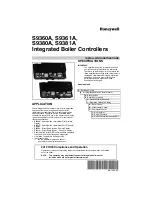
HAMWORTHY HEATING LTD
MILBORNE 500 SERIES
500001130/A
4
4.0 Controls Philosophy
The Milborne 500 series boiler is supplied with a
sophisticated integrated control system. This system
works with the Master and Slave principle of control
allowing several boilers to be installed all operating
from one control system.
The Master boiler is available as either the Milborne
501 or the Milborne 502. Each Master boiler is
equipped with a digital control panel as the user
interface and heating controller.
Additional Slave boilers are available as Milborne
502 models allowing combinations using one Master
boiler to be assembled as modular installations.
Boiler sequencing is commanded from the Master
boiler with lead boiler rotation based on hours run.
Each Master boiler is supplied with a temperature
sensor for fitting in the common flow pipework. This
must be positioned after the last boiler connection in
a cascade arrangement on the flow pipework
closest to the heating circuits.
Summer shutdown is based on outside air
temperature measured from the outside air
temperature sensor supplied with each Master
boiler. An adjustable parameter allows setting for
the outside temperature at which the heating circuits
are disabled.
Frost protection is also facilitated from the outside
air temperature sensor. Stage 1 will start the primary
pump, or the high temperature heating circuit pump
where a primary pump is not used. Stage 2 will
enable the boilers based on water temperature
within the heating circuit at a temperature configured
in the parameter settings.
Weather compensation is available for the heating
circuits based on outside air temperature and a
common curve. Each heating circuit can be offset
from this curve by setting the maximum and
minimum water temperatures in the parameters.
From the Master boiler it is possible to control 2
heating circuits and a DHW circuit. The heating
circuits are designated as high temperature heating
circuit and low temperature heating circuit. The latter
incorporates control outputs for both the pump and a
mixing valve whilst the high temperature circuit and
DHW circuit have only outputs for pump control.
All 3 circuits can be set in the parameters to operate
at different temperatures. The low temperature
heating and DHW circuits have additional optional
sensors for control of water temperature.
DHW can be set in the parameters to operate with
traditional calorifiers or plate heat exchangers using
voltage free switching thermostats.
Where the heating circuits are controlled from the
Master boiler control panel and not all three
secondary heating circuits are installed, the unused
circuits can be disabled in the parameter settings.
Pump designation
A maximum of 3 pumps can be controlled from the
Master boiler. Should a primary pump be required
for a primary circuit, then pump 3, normally used for
the low temperature heating circuit, must be re-
designated in the parameter settings as a primary
pump. The secondary circuit capability of the boiler
is then restricted to DHW and high temperature
heating.
However the high temperature heating circuit can be
set to operate at condensing low temperatures and
use weather compensated flow temperature.
Pump control.
When using weather compensated heating circuits
with DHW the pumps are controlled in the following
manner.
When there is a DHW demand requiring higher
primary temperatures the pump for the high
temperature heating circuit is switched off. For the
low temperature heating circuit the pump remains
running whilst the mixing valve is modulated to
prevent higher temperature water entering the
circuit.
At the end of the DHW demand the DHW pump is
switched off and the high temperature heating circuit
pump switched on again. The low temperature
heating circuit mixing valve is re-modulated to suit
the new primary water temperature. Primary water
temperature is set to the higher of the two heating
circuit requirements.
When only one circuit requires heat the primary
water temperature is set to the requirement of that
circuit.
Pump over-run
A separate adjustable parameter is provided for all
three pumps to facilitate pump over-run. This will
remove residual heat from the boiler when the last
circuit is signalled off by the relevant time clock or
thermostat.
These parameters are set as part of the
commissioning procedure and can be adjusted
between 0 and 255 minutes.
Temperature control
Whilst the maximum and minimum settings for the
heating circuits are set by the parameters at











































